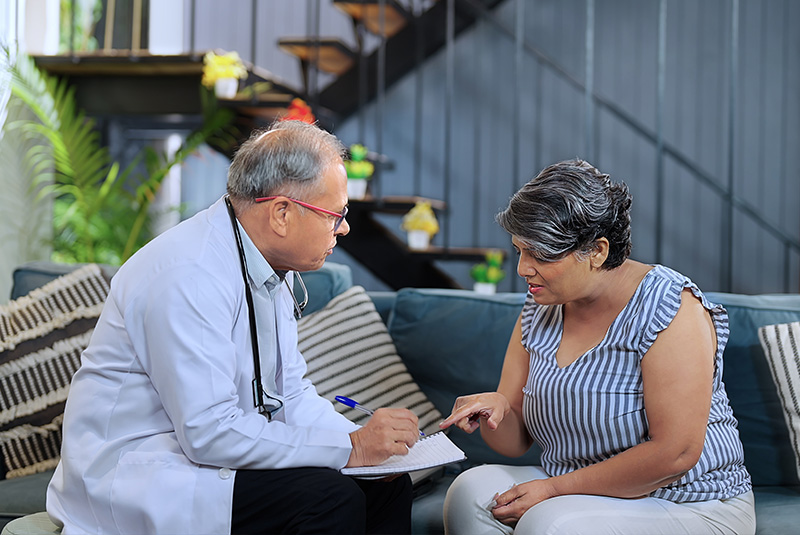

You are now leaving GSK’s website and are going to a website that is not operated/controlled by GSK. Though we feel it could be useful to you,we are not responsible for the content/service or availability of linked sites. You are therefore mindful of these risks and have decided to go ahead.
Agree Agree Agree Stay
Did you know anyone who has previously had chickenpox is at risk of developing shingles later in life? 1 Shingles is a viral disease that causes a painful, blistering rash, typically appearing on one side of the body 1#. Although chickenpox is commonly experienced during childhood 2, the virus responsible, known as the varicella-zoster virus, can remain inactive in the nervous system for many years before reactivating as shingles 1.
In this blog, we’ll discuss the symptoms of shingles, including the signature rash, pain, and other related complications. We will also discuss factors that can increase your risk of developing shingles and prevention strategies to help you reduce your risk.
But first, let’s understand the meaning of shingles.
Shingles, medically called herpes zoster, is an infection caused by the reactivation of the varicella-zoster virus 1, which remains dormant in the ganglionic neurons throughout the nervous system after a person recovers from chickenpox 3. It can reactivate years later, often due to a decline in varicella-zoster virus-specific cell-mediated immunity, and travel along the nerve fibres to the skin, resulting in a painful rash 1#,3#.
Shingles can develop at any age 4, but it primarily affects individuals over 50 and those with weakened immune systems 5.
Although the condition is not life-threatening 4, it can cause unbearable pain 6# and, in some cases, lead to complications, such as postherpetic neuralgia 6, herpes zoster ophthalmicus 7, herpes zoster oticus 8, pneumonia 6, and bacterial infection 6.
Individuals with shingles often experience pain, burning, or tingling sensations in a specific area of the skin, typically where the rash will eventually develop 6#.
Shingles pain can be unbearable and may persist for weeks or even months 6#, often described as more painful than that experienced during a chickenpox infection 9#.
Many people describe the pain of shingles as similar to electric shocks, piercing sensations, or unbearable burning 10#.
Shingles pain can impact various aspects of daily life, including 11#:
In addition to pain, some individuals may experience other shingles symptoms, such as 6:
Early symptoms of shingles can occur several days before the rash appears 6.
The shingles rash is one of the primary symptoms of the condition. It typically appears as a single stripe on either the left or right side of the body, but it can also appear on one side of the face, arms, or head. In some cases, it may even affect the ears and eyes 4,6.
Although rare, the rash can become more widespread and resemble a chickenpox rash, particularly in individuals with weakened immune systems 6.
The shingles rash consists of blisters that usually dry within 7 to 10 days, leaving behind yellow scabs 4,6. Generally, the rash does not cross the body's midline 12. In adults, shingles typically resolves within two to four weeks, while children and young individuals usually experience milder cases 4. Most adults will only have shingles once in their lifetime 4.
However, shingles can lead to complications even after the rash has cleared 6. These complications include:
Now that you know the signs and symptoms of herpes zoster, let's understand its causes.
Several factors can increase the risk of developing shingles disease and its associated symptoms:
Additionally, individuals aged 50 and older who contract COVID-19 may experience an increased risk of developing shingles for up to six months following their diagnosis 16. Moreover, cancer treatments - such as chemotherapy, radiotherapy, high doses of steroids, and targeted cancer drugs - can also increase the risk 13,17.
Vaccination against shingles is an effective way to reduce the risk of developing the condition, including its rash and other symptoms 18. The shingles vaccination is safe and over 90% effective 18, increasing the body’s natural defences and helping build immunity against the varicella-zoster virus 19.
The vaccination is recommended for 18:
For more information on shingles prevention, consult your healthcare provider.
Conclusion
Shingles, a painful viral disease, is caused by the reactivation of the varicella-zoster virus, the same microorganism that causes chickenpox 1. Although it can affect anyone who has had chickenpox 1, it is most common in individuals over 50 5. Symptoms of shingles disease include a painful, blistering rash, often accompanied by pain, fever, and other symptoms 6#.
While the condition is not life-threatening 4, herpes zoster can cause unbearable pain and lead to complications, such as postherpetic neuralgia 6#.
Consider vaccination to reduce your risk of developing shingles, especially if you are over 50 18. By understanding the symptoms, risk factors, and preventive measures, you can take steps to protect yourself from this painful condition.
#Individual patient symptoms of Shingles may vary. These statements are based on some patients’ descriptions of their shingles' pain and do not represent every patient’s experience.
References
Disclaimer:
A public awareness initiative by GlaxoSmithKline Pharmaceuticals Limited, Dr. Annie Besant Road, Worli, Mumbai 400 030, India. Information appearing in this material is for general awareness only. Nothing contained in this material constitutes medical advice. Please consult your doctor for medical advice or any question or concern you may have regarding your condition. Please consult your doctor for the complete list of vaccine-preventable diseases and the complete vaccination schedule for each disease. Trademarks are owned by or licensed to the GSK group of companies. All scientific information is validated, for details write to us on askus@gsk.com. ©️2025 GSK or Licensor.
Cl code: NP-IN-HZU-WCNT-240004
Dop: February 2025
